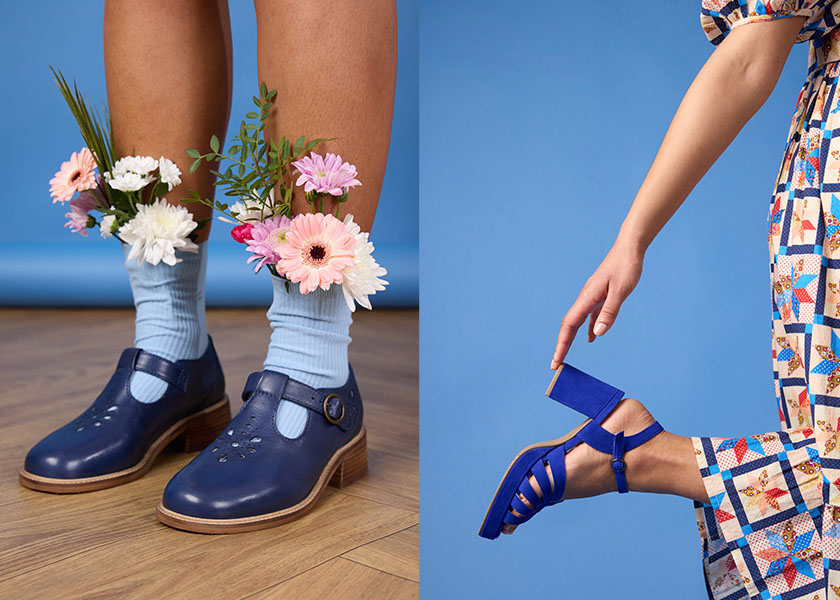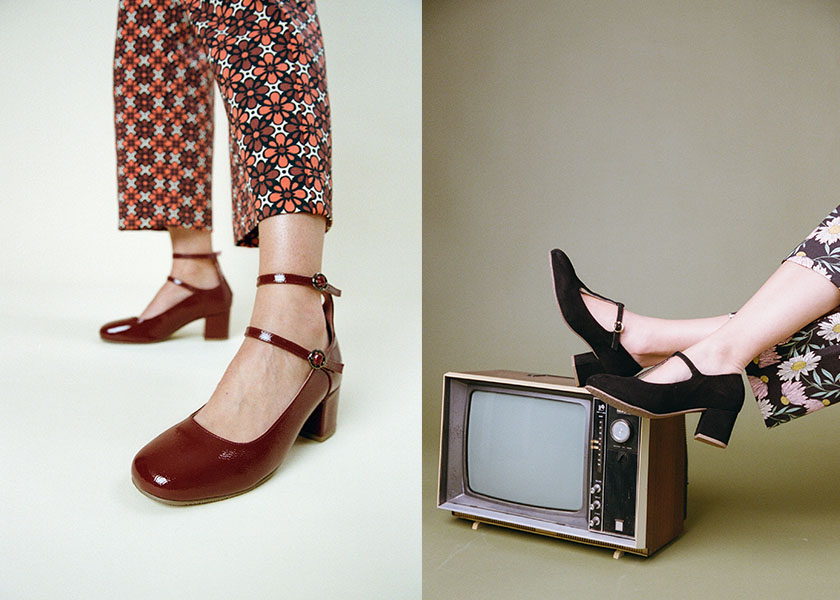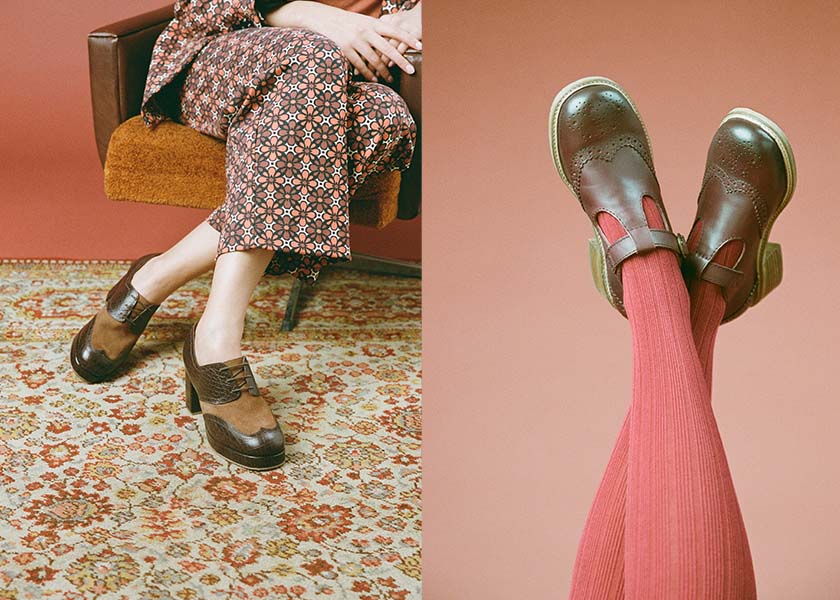To celebrate the launch of our first-ever range of Joanie Shoes, we sat down with Freelance Shoe Designers Jess and Jo to learn more about what it was like to create vintage-inspired shoes for the modern wardrobe and why sustainability and longevity are at the heart of the collection.
Q: Hi Jess and Jo! Can you each tell us a bit about yourselves and your careers so far designing shoes?
Jess: I started out in the sports trade, designing for soccer, cricket, baseball, and American football, working with household-name sports stars here and abroad. I then moved into fashion, working for quirky fashion brands, and even did stints designing for the high street.
I’ve been freelance for over 20 years now. I’m a technical designer, so as well as creating pretty shoes, I geek out on factory processes, components, and tech packs. I love my job so much - I’ll still be designing shoes when I’m 80! My other passion is boats. I have lived on my narrowboat for 18 years, and I’m a continuous cruiser because I thrive on variety.
Jo: My first job was working at Clarks as a fitting assistant when I was 14! I later went on to do a degree in Footwear Design and Development at Cordwainers at the London College of Fashion. Over the last 20 years, I have worked in Design, Development, and Technical (fit). I worked out recently that I’ve been to see shoe factories in 11 different countries to date.
Over the past 12 years, I have freelanced and worked for various brands, from large high street retailers to small start-ups. I love the variety that comes with freelancing and the people you get to meet - each year feels quite adventurous! It's been such an adventure working with the Joanie team, helping with sourcing and visiting the factory.
Tell us about the design process - what was it like to create Joanie’s new range of shoes?
Jess: I’ve always loved vintage shoes, fashion, and junk – you can always find me hunting at the charity shop or car boot sale, so it was a joy to create these shoes. The trouble is - vintage shoes don’t fit modern feet. We want more comfort! So, to create this range of Joanie Shoes, we developed our own lasts and heels, updated the styling and fitting, and selected quality, sustainable, and natural materials to keep the same vintage vibe without crushing your toes!
Jo: Joanie brought me in as a freelancer to work on the technical side of things: the fit, quality, and general product development of the shoes. The design process starts with Lucy and Jess - they come up with the shapes, colours, and ideas, then we get our lastmaker, Mike, at Springline in the UK, to create the lasts for us, then we work as a team with the factory to create the samples.
Once I receive the samples from our factory, I start the rigorous process of fit-testing the shoes on a few fit models I've measured to be within our average size specs. We look at where the shoes fit well and where they don't, and make adjustments that we feel will improve the overall fit. Then, we create a new round of samples with these aesthetic and fit improvements: sometimes, it takes three or four rounds to get the fit right! We also check the fit across the entire size run - a size 4, 6, and 8, to ensure the grading is correct.
Can you tell us a little bit about what makes Joanie Shoes sustainable and why that was such an important part of the design process?
Jess: Shoes that don’t fit well or fall apart are not sustainable because they lead to a cycle of purchase-disappointment-discard-repeat. Shoes that are too worn-out to donate or re-sell are discarded or incinerated - not recycled. We fit our shoes on a range of sizes, and we wear-trial them ourselves to check they’re comfy and durable. Most importantly, we select the materials we make our shoes from with care to ensure they last. Ultimately, we have designed high-quality, repairable shoes that can be loved and worn for a long time.
Jo: As a business, Joanie is committed to only working with suppliers that hold Smeta 4 Pillar audits: this is the gold-standard for sustainability in production processing, investigating labour standards, health and safety, business ethics, and sustainability. We found that most factories only held a 2 Pillar audit (a more basic inspection that only investigates labour standards and health and safety), but after months of searching, we were so chuffed when we finally found 'the one.'
We were keen to source the most sustainable materials available to us, so we opted for leathers from Gold Standard Leather Working Group tanneries. These are the top level tanneries that have achieved the best level of sustainable practices, from ethics, to processes and sourcing. We opted for insole boards made from jute, a more sustainable alternative to the fibreboard that we sourced locally to our suppliers in India to reduce the overall carbon footprint.
One of - if not the most - important parts of ensuring Joanie Shoes are sustainable is making sure they are durable. We want them to last as long as possible, and because of this, we haven't hopped on some 'sustainable trends': we didn't choose recycled soles because the durability was not up to our standards. We chose a less-sustainable rubber mix sole because being able to love and wear a pair of shoes for a long time is far more sustainable than having to replace them when the soles wear out quickly.
What would your top care tips be to keep Joanie Shoes looking great for longer?
Jess: If they get wet, don’t dry them close to a heat source, and stuff them with newspaper to help maintain the shape. To clean and polish, use a brush to remove any loose dirt, then apply polish with a cloth and rub it in, leave for 15-20 minutes, then buff it off with a soft cloth. You can remove stains or marks from suede with a crepe eraser or a piece of crepe rubber (look on eBay) - just rub them out!
Regularly check the heels and soles of your shoes for wear, and get a cobbler to replace the top lifts (the ends on the heels) and resole them before they get too worn. If you find you’re wearing your heels down a lot on one side, you can buy half insole orthotics to correct the way you walk: this will make your shoes last longer and also make your feet and legs less likely to ache.
Jo: Using a protector spray is always a good plan, specifically for suedes, oiled leathers, and anything made of a porous material. Like Jess said, if your shoes get wet, it helps to pack them out with tissue in the toe area before the dry to help them keep a lovely shape.
But, for the most part, especially with metallic leathers – be gentle with them. Remember that walking over a gravel drive could ruin the leather by scratching it!
Shop Joanie Shoes online now!











